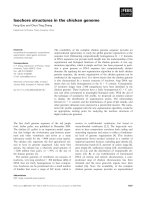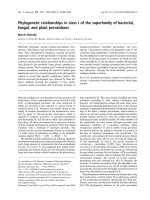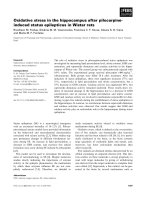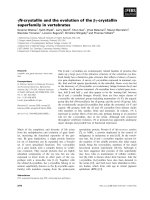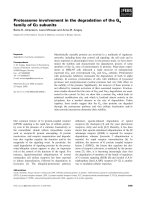Báo cáo khoa học: "Lexical Selection in the Process of Language Generation" ppt
Bạn đang xem bản rút gọn của tài liệu. Xem và tải ngay bản đầy đủ của tài liệu tại đây (451.95 KB, 6 trang )
Lexica] Selection in the Process of Language Generation
3ames Pustejovsky
Department of Computer Science
Brandeis University
Waltham, MA 02254
617-736-2709
j amespQ brandeis.caner -relay
Sergei Nirenburg
Computer Science Department
Carnegie-Mellon University
Pittsburgh, PA. 15213
412-268-3823
sergeiQcad.cs.cmu.edu
Abstract
In this paper we argue that lexical selection plays a more
important role in the generation process than has com-
monly been assumed. To stress the importance of lexical-
semantic input to generation, we explore the distinction
and treatment of generating
open
and closed cla~s lexical
items, and suggest an additional classification of the lat-
ter into
discourse-oriented
and
proposition-oriented
items.
Finally, we discuss how lexical selection is influenced by
thematic
([oc~)
information in the input.
I. Introduction
There is a consensus among computational linguists
that a comprehensive analyzer for natural language must
have the capability for robust lexical disambiguation,
i.e., its central task is to select appropriate meanings of
lexical items in the input and come up with a non contra-
dictory, unambiguous representation of both the proposi-
tional and the non-propositional meaning of the input text.
The task of a natural language generator is, in some sense,
the opposite task of rendering an unambiguous meaning
in a natural language. The main task here is to to per-
form principled selection of a) lexical items and b) the
syntactic structure for input constituents, based on lexical
semantic, pragmatic and discourse clues available in the
input. In this paper we will discuss the problem of lexlcal
selection.
The problem of selecting lexical items in the pro-
cess of natural language generation has not received as
much attention as the problems associated with express-
ing explicit grammatical knowledge and control. In most
of the generation systems, lexical selection could not be
a primary concern due to the overwhelming complexity
of the generation problem itself. Thus, MUMBLE con-
centrates on gr:~mmar-intensive control decisions (McDon-
ald and Pustejovsky, 1985a) and some stylistic considera-
tions (McDonald and Pustejovsk'y, 1985b); TEXT (McKe-
own, 1985) stresses the strategical level of control decisions
about the overall textual shape of the generation output.
~KAMP (Appelt, 1985) emphasizes the role that dynamic
planning plays in controlling the process of generation,
and specifically, of referring expressions; NIGEL (Mann
and Matthiessen, 1983) derives its control structures from
the choice systems of systemic grammar, concentrating on
grammatical knowledge without fully realizing the 'deli-
cate' choices between elements of what systemicists call
leto's (e.g., HaLiiday, 1961). Thus, the survey in Cummlng
(1986) deals predominantly with the grammatical aspects
of the lexicon.
We discuss here the problem of lexical selection and
explore the types of control knowledge that are neces-
sary for it. In particular, we propose different control
strategies and epistemological foundations for the selec-
tion of members of a) open-class and b) closed-class lex-
ical items. One of the most important aspects of control
knowledge our generator employs for lexical selection is the
non-propositional information (including knowledge about
focus and discourse cohesion markers). Our generation
system incorporates the discourse and textual knowledge
provided by TEXT as well as the power of MUMBLE's
grammatical constraints and adds principled lexical selec-
tion (based on a large semantic knowledge base) and a
control structure capitalizing on the inherent flexibility of
distributed architectures. 2 The specific innovations dis-
cussed in this paper are:
I Derr and McKeown, 1984 and McKeown, 1985, however,
discuss thematic information, i,e. focus, as a basis for the selec-
tion of anaphoric pronouns. This is a fruitful direction, and we
attempt to extend it for treatment of additional discourse-based
phenomena.
2 Rubinoff (1986) is one attempt st integrating the tex-
tual
component of TEXT with the grammar of MUMBLE. This
interesting idea leads to a significant improvement in the perfor-
mance of sentence production. Our approach differs from this
effort in two important repsects. First, in Rubinoff's system the
output of TEXT serves as the input to MUMBLE, resulting in
a cascaded process. We propose a distributed control where the
separate knowledge sources contribute to the control when they
can, opportunistically. Secondly, we view the generation process
as the product of many more components than the number pro-
posed in current generators. For a detailed discussion of these
see Nirenburg and Pu~tejovslry, in preparation.
201
I. We attach importance to the question
of
what the input
to a generator should be, both as regards its content and
its form; thus, we maintain that discourse and pragmatic
information is absolutely essentiM in order for the genera-
tor to be able to handle a large class of lexicM phenomena;
we distinguish two sources of knowledge for lexicM selec-
tion, one discourse and pragznatics-based, the other lexicM
semantic.
2. We argue that lexicM selection k not just a side ei~ect
of
grammatical decisions but rather ~ts to flexibly constrain
concurrent and later generation decisions of either lexicM
or ~aticM type.
For comparison, MUMBLE lexical selections are per-
formed after some grammatical constraints have been used
to determine the surface syntactic structure; this type of
control of the generation process does not seem optimal
or su~icient for all generation tasks, although it may be
appropriate for on-line generation models; ; we argue that
the decision process is greatly enhanced by making lexicM
choices early on in the process. Note that the above
does
not presuppose that the control structure for generation ls
to be like cascaded transducers; in fact, the actual system
that we are building based on these principles, features a
distributed architecture that supports non-rigid decision
making (it follows that the lexical and grammatical deci-
sions are not explicitly ordered with respect to each other).
This architecture is discussed in detail in Nirenburg ~nd
Pustejovsky, in preparation.
3. We introduce an important distinction between open-
class and closed-class lexical items in the way they are rep-
resented as
well as the way they are processed by our gen-
erator; our computational, processing-oriented paradigm
has led us to develop a finer classification of the closed-
class items than that tr~litionMly acknowledged in the
psycholinguistic literature; thus, we distinguish between
discourse oriented closed-class (DOCC) items and propo-
sition oriented ones (POCC);
4. We upgrade the importance of knowledge about focus
in the sentence to be generated so that it becomes one of
the prime heuristics for controlling the entire generation
process, including both lexical selection and grammatical
phrasing.
5. We suggest a comprehensive
design
for the concept lex-
icon component used by the generator, which is perceived
as a combination of a gener'M-purpose semantic knowl-
edge base describing a subject domain (a subworld) and
a generation-specific lexicon (indexed by concepts in this
knowledge base) that consists of a large set of discrimi-
nation nets with semantic and pragmatic tests on their
nodes.
These discrimination nets are distinct from the choo-
sers in NIGEL's choice systems, where grammatical knowl-
edge is not systematically separated from the lexical se-
mantic knowledge (for a discussion of problems inherent
in this approach see McDonald, Vaughau and Pustejovsky,
1986); the pragmatic nature of some of the tests, as well
ms the fine level of detail of knowledge representation is
what distinguishes our approach from previous conceptual
generators, notably
PHRED (Jscobs, 1985)).
2. Input to Generation
As in McKeown (1985,1986) the input to the pro-
cess of generation includes information about the discourse
within which the proposition is to be generated. In our sys-
tem the following static knowledge sources constitute the
input to generation:
1. A representation of the meaning of the text to be gener-
ated, chunked into proposition-size modules, each of which
carries its own set of contextual values; (cf. TRANSLA-
TOR, Nirenburg et al., 1986, 1987);
2. the semantic knowledge base (concept lexicon) that
contains information about the types of concepts (objects
(mental, physical and perceptuM) and processes (states
and actions)) in the subject domain, represented with the
help of the description module (DRL) of the TRANSLA-
TOR knowledge representation language. The organiza-
tiona~ basis for the semantic knowledge base is an empir-
ically derived set of inheritance networks (isa, m~ie-of,
belongs-to, has-as-part, etc.).
3. The specific lexicon for generation, which takes the form
of a set of discrimination nets, whose leaves are marked
with lex/cal units or lexicM gaps and whose non-leaf nodes
contain discrimination criteria that for open-class items are
derived from selectional restrictions, in the sense of Katz
and Fodor (1963) or Chomsk'y (1965), as modified by the
ideas of preference semantics (Wilks, 1975, 1978). Note
that most closed.class items have a special status in this
generation lexicon: the discrimination nets for them axe
indexed not by concepts in the concept lexicon, but rather
by the types of values in certain (mostly, nonpropc~itional)
slots in input frames;
4. The history of processing, structured Mong the lines of
the
episodic
memory
oWaa~zat~on
suggested by Kolodner
(1984) and including the feedback of the results of actual
lexic~l choices during the generation of previous sentences
in a text.
202
3. Lexical Classes
The distinction between the open- and closed-class
lexical unite has proved an important one in psychology
and psycholinguistics. The manner in which retrieval of el-
ements from these two classes operates is taken as evidence
for a particular mental lexicon structure. A recent pro-
posal (Morrow, 1986) goes even further to explain some of
our discourse processing capabilities in term~ of the prop-
erties of some closed-da~ lexicM items. It is interesting
that for this end Morrow assumes, quite uncritically, the
standard division between closed- and open-cla~ lexical
categories: 'Open-class categories include content words,
such as nouns, verbs and adjectives Closed-class cate-
gories include function words, such as articles and prepo-
sitions ' (op. cir., p. 423). We do not elaborate on the
definition of the open-class lexical items. We have, how-
ever, found it useful to actually define a particular subset
of dosed-class items as being discourse-oriented, distinct
from those closed-class items whose processing does not
depend on discourse knowledge.
A more complete list of closed-class lexical items
will include the following:
• determiners and demonstratives
(a, the, thiJ, tl~t);
• quantifiers
(most, e~ery, each, all o/);
•
pronouns
(he,
her, its);
• deictic terms and indexicats
(here, now, I, there);
• prepositions (on,
during, against);
. paxentheticals and attitudinal~
(az a matter off act,
o~
the
contrary);
•
conjunctions, including discontinuous ones
(and, be.
r.~e, neither nor);
primary verbs
(do, have,
be);
•
modal verbs
(shall, might, aurar to);
•
wh-words
(toho, why, how);
• expletives (no,
yes, maybe).
We
have concluded that the above is not a homoge-
neous list; its members can be characterized on the basis of
what knowledge sources axe used to evaluate them in the
generation process. We have established two such distinct
knowledge sources: purely propositional information and
contextual and discourse knowledge. Those closed-class
items that are assigned a denotation only in the context
of an utterance will be termed discourse-oriented closed
class (DOCC) items; this includes determiners, pronouns,
indexicals, and temporal prepositions. Those contributing
to the propositional content of the utterance will be called
proposition-oriented closed-class (POCC) items.
These
in-
clude modals, locative and function prepositions, and pri-
mary verbs.
According to this classification, the ~definitenees
effect" (that is, whether a definite or an intefinite noun
phrase is selected for generation) is distinct from general
quantification, which appears to be decided on the basis
of propositional factors. Note that prepositions no longer
form a natural class of simple closed-class items. For ex-
ample, in (I) the preposition
before
unites two entities con-
nected through a discourse marker. In (2) the choice of the
preposition on is determined by information contained in
the propositional content of the sentence.
(I) John ate breakfast bet'ore leaving for work.
(2) John
sat
on the bed.
We will now suggest a set of processing heuristics for
the lexical selection of a member from each lexical class.
This classification entails that the lexicon for generation
will contain only open-cla~ lexical items, because the rest
of the lexical items do not have an independent epistemo-
logical status, outside the context of an utterance. The
selection of closed-class items, therefore, comes as a result
of the use of the various control heuristics that guide the
process of generation. In other words, they axe incorpo-
rated in the procedural knowledge rather than the static
knowledge.
4.0 Lexical Selection
4.1 Selection of
Open-Class Items
A significant problem in lexical selection of open-
class items is how well the concept to be generated matches
the desired lexical output. In other words, the input to
generate in English the concept 'son's wife's mother' will
find no single lexical item covering the entire expression. In
Russian, however, this meaning is covered by a single word
'swatja.' This illustrates the general problem of lexlcal
gaps and bears on the question of how strongly the con-
ceptual representation is influenced by the native tongue of
the knowledge-engineer. The representation must be com-
prehensive yet flexible enough to accommodate this kind
of problem. The processor, on the other hand, must be
constructed so that it can accommodate lexical gaps by
being able to build the most appropriate phrase to insert
in the slot for which no single lexical unit can be selected
(perhaps, along the lines of McDonald and Pustejovsky,
1985a).
To illustrate the knowledge that bears upon the
choice of an open-class lexicM item, let us trace the process
of lexicai selection of one of the words from the list:
desk,
table, dining table, coffee table, utility table.
Suppose, dur-
ing a run of our generator we have already generated the
following p~ tial sentence:
(3)
John bought a
and the pending input is as partially shown in Figures 1-3.
Figure I contains the instance of a concept to be generated.
203
(stol$4
(instance-of
8tel)
(coXor
black)
(size
8m~l)
(height
average)
(:as.
auerafe)
(a,~e-of
ateel)
(location-of #~t))
F|~Lre I
(stol
(i., furniture)
(color
black brown yellow white)
(size
amaJl
average)
(height
lOW averGgs high)
(was.
les~-than-avsmqe averaqe)
(aade-of
t~ood
plastic steel)
(Iocatlon-of
e~t write sew work)
(has-as-pert (
leg leg leg (leg) top)
(topolol7 O| (top loS)))
Figure 2
Figure 2 contains the representation of the corresponding
type in the semantic knowledge base. Figure 3 contains an
excerpt from the English generation lexicon, which is the
discrimination net for the concept in Figure 2.
cuo
location-of of
eat:
cuo height of
low:
co~ree
table
avnrqe :
dining table
~.te:
demk
sev:
sewing table
saw:
workbench
otherwise:
table
Figure 3
In order to select the appropriate lexicalization the
generator has to traverse the discrimination net, having
first found the answers to tests on its nodes in the repre-
sentation of the concept token (in Figure 1). In addition,
the latter representation is compared with the represen-
tation of the concept type and if non-default values are
found in some slots, then the result of the generation will
be a noun phrase with the above noun as its he~l and a
number of ~ljectival modifiers. Thus, in our example, the
generator will produce 'bla~.k steel dining table'.
4.2 Selection of POCC Items
Now let us discuss the process of generating a propo-
sition oriented lexical item. The example we will use here
is that of the function preposition
to.
The observ'4tion
here is that if to is a POCC item, the information required
for generating it should be contained within the proposi-
tional content of the input representation; no contextual
information should be necessary for the lexical decision.
A~ume that we wish to generate sentence (1) where we
axe focussing on the selection of
to.
(1) John walked
to
the store.
If the input to the gener~tor is
(walk
(Actor John)
(Location
"hers')
(Source U)
(Goal
stars23)
(TL~o
past2)
(intention U)
(Direction otare~3) )
then the only information necessary to generate the prepo-
sition is the case role for the goal,
8tore.
Notice that a
change in the lexicalization of this attribute would only
arise with a different input to the generator. Thus, if the
goal were unspecified, we might generate (2) instead of (1);
but here the propositional content is different.
(2) John walked towards the store.
In the complete paper we will discuss the generation of two
other DOCC items; namely, quantifiers and primary verbs,
such as
do and have.
4.2 Selection of DOCC Items:
• Generating a discourse anaphor
Suppose we wish to generate an anaphoric pronoun
for an NP in a discourse where its antecedent was men-
tioned in a previous sentence. We illustrate this in Figure
2. Unlike open-cl~s items, pronominals axe not going to
be directly a~ociated with concepts in the semantic kn-
woledge b~se. Rather, they are generated as a result of
decisions involving contextual knowledge, the beliefs of the
speaker and hearer, and previous utterances. Suppose, we
have alre~ly generated (4) and the next sentence to be
generated a.l~o refers to the same individual and informs
us that John was at his father's for two days.
(1) John, visited his father.
(2)
He~ stayed for two days.
Immediate/ocuz
information, in the sense of Grosz (1979)
interacts with a history of the previous sentence struc-
tures to determine a strategy for selecting the appropriate
anaphor. Thus, selecting the appropriate pronoun is an
attached procedure. The heuristic for discourse-directed
pronomin~ization is as follows:
204
IF:
(I) the input for the generation of a sentence
includes an instance of an object present in a recent
input; and
(2) the the previous instance of this object (the po-
tential antecedent} is in the topic position; and
(3) there are few intervening potential antecedents;
and
(4} there is no focus shift in the space between the
occurrence of the antecedent and the current object
instance
THEN:
realize the current instance of that object as a pro-
noun; consult the grammatical knowledge source for
the proper gender, number and case form of the pro-
noun.
In
McDonald and Pustejovsky (1985b) a heursitic
was given for deciding when to generate a full NP and
when a pronoun. This decision was fully integrated into
the grammatical decisions made by MUMBLE in terms of
realization-classes, and was no different from the decision
to make a sentence active or passive. Here, we are separat.
ing discourse information from linguistic knowledge. Our
system is closer to McKeown's (1985, 1986) TEXT system,
where discourse information acts to constrain the control
regimen for Linguistic generation. We extend McKeown's
idea, however, in that we view the process of lexical selec-
tion as a constraining factor i~ geruera/. In the complete
paper, we illustrate how this works with other discourse
oriented dosed-class items.
5. The Role of Focus in Lexical Selection
As witnessed in the previous section, focus is an im-
portant factor in the generation of discourse anaphors. In
this section we demonstrate that focus plays an important
role in selecting non-discourse items as well. Suppose your
generator has to describe a financial transaction as a result
of which
(I) Bill is the owner of a car that previously belonged
to John, and
(2) John is richer by
$2,000.
Assuming your generator is capable of representing the
~atical structure
of
the resulting-English sentence,
it still faces an important decision of how to express lexi-
cally the actual transaction relation. Its choice is to either
use buy
or
8ell as
the main predicate, leading to either (I)
or (2), or to use a non-perspective phrasing where neither
verb is used.
(1) Bill bought a car from John for $2,000.
(2) John sold a car to Bill for $2,000.
We distinguish the following major contributing factors for
selecting one verb over the other;, (I) the intended perspec-
tive
of the situation, (2) the emphasis of one activity rather
than another, (3) the focus being on a particular individ-
ual, and (4) previous lexicalizations of the concept.
These observations are captured by allowing/ocu8
to operate over several expression including event-types
such as tra~/sr.
Thus, the variables at pIw for focus in-
dude:
•
end-of-transfer,
• beginning-of-transfer,
• activity-of- transfer,
• goal-of-object,
• source-of-object,
• goal-of-money,
• source-of-money.
That is, lexical/zation depends on which expressions are in
focus. For example, if John is the immediate focus (as in
McKeown (1985)) and beginning-of-transfer is the current-
focus, the generator will lexicalize from the perspective of
the sell/ng, namely (2). Given a different focus configura-
tion in the input to the generator, the selection would be
different and another verb would be generated.
6. Conclusion
In this paper we have argued that lexJcal selection
is an important contributing factor to the process of gen-
eration, and not just a side effect of grammatical deci-
s/ons. Furthermore, we claim that open-class items are
not only conceptually different from closed-class items, but
are processed differently as well. Closed class items have
no epistemological status other than procedural attach-
ments to conceptual and discourse information. Related to
this, we discovered an interesting distinction between two
types of closed-class items, distinguished by the knowledge
sources necessary to generate them; discourse oriented and
proposition-oriented. Finally, we extend the importance of
focus information for directing the generation process.
205
References
[1] Appelt, Dougla~
Planning Enqlish Sentences, Cam.
bridge U. Press.
[2] Chomsky, Noam A~pec~
on
tM. Theo~ o!
$ynt~
MIT Press.
[3] Cumming, Susanna, "A Guide to Lexical Acquisi-
tion in the JANUS System" ISI Research Report
ISI/RR-85-162, Information Sciences Institute, Ma-
rina del Rey, California~ 1986a.
[4] Cvmming, Stumana, "The Distribution
of I.,exic.M
Information in Text Generation', presented for Work-
shop on Automating the Lexicon, Pisa~ 1986b.
[5] Den', K. and K. McKeown "Focus in Generation,
COLING 1984
[6] Dowty, David R., Word Meaning and Montague
Grammar, D. Reidel, Dordrecht, Holland, 1979.
[7] Hall/day, M.A.K. ~Options and functions in the En-
gl~h clause m.
Brno Studies in Enfli~h
8, 82-88.
[8] Jacobs, Paul S., "PHRED: A Generator for Nat-
ural Language Interface', Computational Linguis-
tics, Volume 11, Number 4,
1085.
[9] Katz, Jerrold and Jerry A. Fodor, "The Structure of
a Semantic Theory', Language Vol 39, pp.170-210,
1963.
[10] Mann, William and Matthiessen, "NIGEL: a Sys-
temic Grammar for Text Generation', in Freddle
(ed.), Systemic Perspectives on Discoerae,
Ablex.
[11] McDonald, David and James Pustejovsky, "Descrip-
tion directed Natural Language Generation" Pro-
ceedings of IJCAI-85. Kaufmann.
[12] McDonald, David and James Pustejovsky, "A Com-
putational Theory of Prose Style for Natural Lan-
guage Generation, Proceedings of the European ACL,
University of Geneva, 1985.
[13]
McKeown, Kathy Tez~
Generatio,~
Cambridge
Uni-
versity Press.
[14] McKeown, Kathy, "Stratagies and Constraints for
Generating Natural Language Text ~, in Bolc and
McDonald, 1087.
[151 Morrow "The Processing of Closed Class Lexical
Items', in Cognitive Science 10.4, 1986.
[161 Nirenburg, Sergei, Victor Raskin, and Allen Tucker,
"The Structure of Interlingua in TRANSLATOR",
in Nirenburg
(ed.)
Machine Translation: Theoret-
ical ~nd Afeth~dolofical ls~ttes,
Cambridge Univer-
sity Pres~. 1987.
[17] Wilks, Yorick "Preference Semantics, ~
Artificial In-
telligence,
1975.
206



